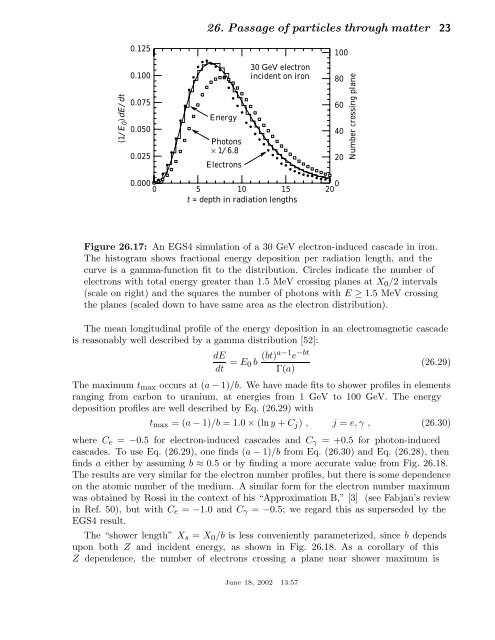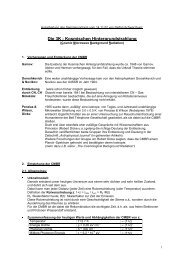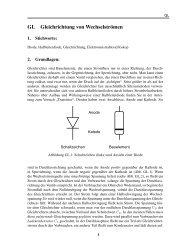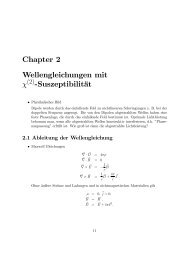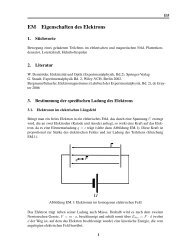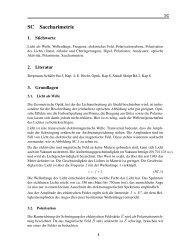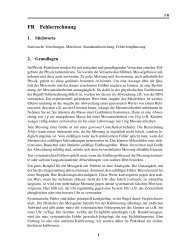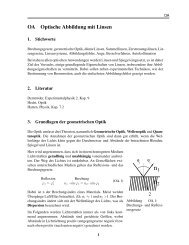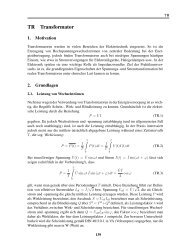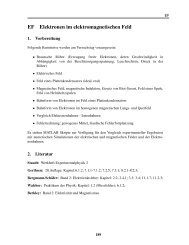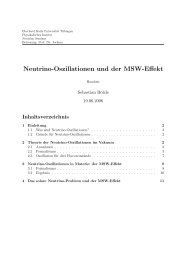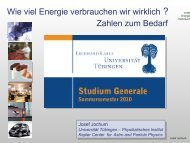26. passage of particles through matter - Particle Data Group
26. passage of particles through matter - Particle Data Group
26. passage of particles through matter - Particle Data Group
Create successful ePaper yourself
Turn your PDF publications into a flip-book with our unique Google optimized e-Paper software.
<strong>26.</strong> Passage <strong>of</strong> <strong>particles</strong> <strong>through</strong> <strong>matter</strong> 23<br />
0.125<br />
100<br />
(1/E 0 ) dE/dt<br />
0.100<br />
0.075<br />
0.050<br />
0.025<br />
Energy<br />
Photons<br />
× 1/6.8<br />
Electrons<br />
30 GeV electron<br />
incident on iron<br />
80<br />
60<br />
40<br />
20<br />
Number crossing plane<br />
0.000<br />
0<br />
0 5 10 15 20<br />
t = depth in radiation lengths<br />
Figure <strong>26.</strong>17: An EGS4 simulation <strong>of</strong> a 30 GeV electron-induced cascade in iron.<br />
The histogram shows fractional energy deposition per radiation length, and the<br />
curve is a gamma-function fit to the distribution. Circles indicate the number <strong>of</strong><br />
electrons with total energy greater than 1.5 MeV crossing planes at X 0 /2intervals<br />
(scale on right) and the squares the number <strong>of</strong> photons with E ≥ 1.5 MeV crossing<br />
the planes (scaled down to have same area as the electron distribution).<br />
The mean longitudinal pr<strong>of</strong>ile <strong>of</strong> the energy deposition in an electromagnetic cascade<br />
is reasonably well described by a gamma distribution [52]:<br />
dE<br />
dt = E 0 b (bt)a−1 e −bt<br />
(<strong>26.</strong>29)<br />
Γ(a)<br />
The maximum t max occurs at (a − 1)/b. Wehavemadefitstoshowerpr<strong>of</strong>ilesinelements<br />
ranging from carbon to uranium, at energies from 1 GeV to 100 GeV. The energy<br />
deposition pr<strong>of</strong>iles are well described by Eq. (<strong>26.</strong>29) with<br />
t max =(a−1)/b =1.0×(ln y + C j ) , j = e, γ , (<strong>26.</strong>30)<br />
where C e = −0.5 for electron-induced cascades and C γ =+0.5 for photon-induced<br />
cascades. To use Eq. (<strong>26.</strong>29), one finds (a − 1)/b from Eq. (<strong>26.</strong>30) and Eq. (<strong>26.</strong>28), then<br />
finds a either by assuming b ≈ 0.5 or by finding a more accurate value from Fig. <strong>26.</strong>18.<br />
The results are very similar for the electron number pr<strong>of</strong>iles, but there is some dependence<br />
on the atomic number <strong>of</strong> the medium. A similar form for the electron number maximum<br />
was obtained by Rossi in the context <strong>of</strong> his “Approximation B,” [3] (see Fabjan’s review<br />
in Ref. 50), but with C e = −1.0 andC γ =−0.5; we regard this as superseded by the<br />
EGS4 result.<br />
The “shower length” X s = X 0 /b is less conveniently parameterized, since b depends<br />
upon both Z and incident energy, as shown in Fig. <strong>26.</strong>18. As a corollary <strong>of</strong> this<br />
Z dependence, the number <strong>of</strong> electrons crossing a plane near shower maximum is<br />
June 18, 2002 13:57


